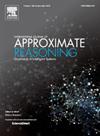A novel active learning approach to label one million unknown malware variants
IF 3
3区 计算机科学
Q2 COMPUTER SCIENCE, ARTIFICIAL INTELLIGENCE
引用次数: 0
Abstract
Active learning for classification seeks to reduce the cost of labeling samples by finding unlabeled examples about which the current model is least certain and sending them to an annotator/expert to label. Bayesian theory can provide a probabilistic view of deep neural network models by asserting a prior distribution over model parameters and estimating the uncertainties by posterior distribution over these parameters. This paper proposes two novel active learning approaches to label one million malware examples belonging to different unknown modern malware families. The first model is Inception-V4+PCA combined with several support vector machine (SVM) algorithms (UTSVM, PSVM, SVM-GSU, TBSVM). The second model is Vision Transformer based Bayesian Neural Networks ViT-BNN. Our proposed ViT-BNN is a state-of-the-art active learning approach that differs from current methods and can apply to any particular task. The experiments demonstrate that the ViT-BNN is more stable and robust in handling uncertainty.
一种新的主动学习方法来标记一百万个未知的恶意软件变体
分类的主动学习旨在通过找到当前模型最不确定的未标记示例,并将其发送给注释者/专家进行标记,从而降低标记样本的成本。贝叶斯理论可以通过断言模型参数的先验分布和通过这些参数的后验分布估计不确定性来提供深度神经网络模型的概率视图。本文提出了两种新的主动学习方法来标记属于不同未知现代恶意软件家族的100万个恶意软件样本。第一个模型是Inception-V4+PCA结合几种支持向量机(SVM)算法(UTSVM、PSVM、SVM- gsu、TBSVM)。第二种模型是基于视觉变换的贝叶斯神经网络ViT-BNN。我们提出的ViT-BNN是一种最先进的主动学习方法,不同于现有的方法,可以应用于任何特定的任务。实验表明,ViT-BNN在处理不确定性方面具有更好的稳定性和鲁棒性。
本文章由计算机程序翻译,如有差异,请以英文原文为准。
求助全文
约1分钟内获得全文
求助全文
来源期刊

International Journal of Approximate Reasoning
工程技术-计算机:人工智能
CiteScore
6.90
自引率
12.80%
发文量
170
审稿时长
67 days
期刊介绍:
The International Journal of Approximate Reasoning is intended to serve as a forum for the treatment of imprecision and uncertainty in Artificial and Computational Intelligence, covering both the foundations of uncertainty theories, and the design of intelligent systems for scientific and engineering applications. It publishes high-quality research papers describing theoretical developments or innovative applications, as well as review articles on topics of general interest.
Relevant topics include, but are not limited to, probabilistic reasoning and Bayesian networks, imprecise probabilities, random sets, belief functions (Dempster-Shafer theory), possibility theory, fuzzy sets, rough sets, decision theory, non-additive measures and integrals, qualitative reasoning about uncertainty, comparative probability orderings, game-theoretic probability, default reasoning, nonstandard logics, argumentation systems, inconsistency tolerant reasoning, elicitation techniques, philosophical foundations and psychological models of uncertain reasoning.
Domains of application for uncertain reasoning systems include risk analysis and assessment, information retrieval and database design, information fusion, machine learning, data and web mining, computer vision, image and signal processing, intelligent data analysis, statistics, multi-agent systems, etc.
 求助内容:
求助内容: 应助结果提醒方式:
应助结果提醒方式:


